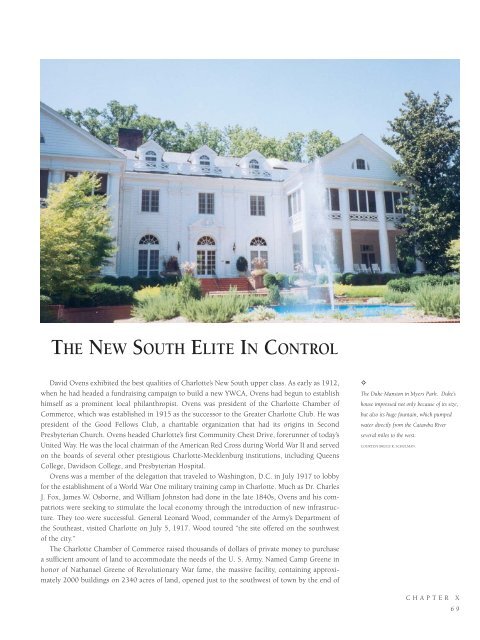Historic Charlotte
An illustrated history of the City of Charlotte and the Mecklenburg County area, paired with the histories of companies, families and organizations that make the region great.
An illustrated history of the City of Charlotte and the Mecklenburg County area, paired with the histories of companies, families and organizations that make the region great.
Create successful ePaper yourself
Turn your PDF publications into a flip-book with our unique Google optimized e-Paper software.
THE NEW SOUTH ELITE IN CONTROL<br />
David Ovens exhibited the best qualities of <strong>Charlotte</strong>’s New South upper class. As early as 1912,<br />
when he had headed a fundraising campaign to build a new YWCA, Ovens had begun to establish<br />
himself as a prominent local philanthropist. Ovens was president of the <strong>Charlotte</strong> Chamber of<br />
Commerce, which was established in 1915 as the successor to the Greater <strong>Charlotte</strong> Club. He was<br />
president of the Good Fellows Club, a charitable organization that had its origins in Second<br />
Presbyterian Church. Ovens headed <strong>Charlotte</strong>’s first Community Chest Drive, forerunner of today’s<br />
United Way. He was the local chairman of the American Red Cross during World War II and served<br />
on the boards of several other prestigious <strong>Charlotte</strong>-Mecklenburg institutions, including Queens<br />
College, Davidson College, and Presbyterian Hospital.<br />
Ovens was a member of the delegation that traveled to Washington, D.C. in July 1917 to lobby<br />
for the establishment of a World War One military training camp in <strong>Charlotte</strong>. Much as Dr. Charles<br />
J. Fox, James W. Osborne, and William Johnston had done in the late 1840s, Ovens and his compatriots<br />
were seeking to stimulate the local economy through the introduction of new infrastructure.<br />
They too were successful. General Leonard Wood, commander of the Army’s Department of<br />
the Southeast, visited <strong>Charlotte</strong> on July 5, 1917. Wood toured “the site offered on the southwest<br />
of the city.”<br />
The <strong>Charlotte</strong> Chamber of Commerce raised thousands of dollars of private money to purchase<br />
a sufficient amount of land to accommodate the needs of the U. S. Army. Named Camp Greene in<br />
honor of Nathanael Greene of Revolutionary War fame, the massive facility, containing approximately<br />
2000 buildings on 2340 acres of land, opened just to the southwest of town by the end of<br />
✧<br />
The Duke Mansion in Myers Park. Duke’s<br />
house impressed not only because of its size,<br />
but also its huge fountain, which pumped<br />
water directly from the Catawba River<br />
several miles to the west.<br />
COURTESY BRUCE R. SCHULMAN.<br />
CHAPTER X<br />
69
















